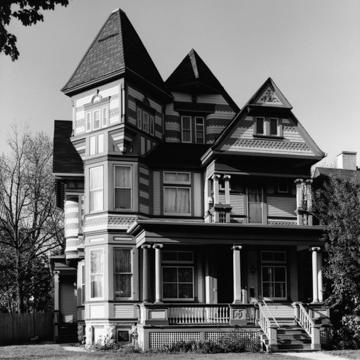The Concordia Historic District is rich in examples of Milwaukee’s turn-of-the-twentieth-century residential styles. Most of the houses were built between 1870 and 1920, but the busiest period of development in the district occurred between 1885 and 1900. At the center of the district is the former campus of Concordia College, a Lutheran liberal arts college founded in 1881. The college moved to Mequon, Ozaukee County, in 1982, and this campus became the American Indian Community School. The exodus of the college and the sale of nearly one hundred houses it owned opened the neighborhood to new owners who rehabilitated and maintained the historic character of the district.
The Italianate Robert Faries House (c. 1850; 3011 W. State Street) is the district’s oldest building and an architectural icon. The original owner was an amateur astronomer, who reportedly modified the roof as an observation deck. One of the city’s finest Shingle Style houses is the Abram Bancker House (1890; 936 N. 31st Street). Shingles on the second and attic stories give a featherlike surface. The Bublitz House (1894; 3019 W. Kilbourn Avenue) exemplifies late Queen Anne style. Its meticulously finished exterior includes wooden Ionic piers and a Palladian motif. At 3035 W. Kilbourn is the German-inspired Ernst Pommer House (1895). Its bell-cast dome atop an octagonal bay window is broken at the eaves by an ornate oval oculus and crowned by a slender spire. The curving front gable is neo-Baroque, as used in residences for Milwaukee’s German American elite during the late nineteenth and early twentieth centuries. Also German Baroque Revival is the Moritz Meissner House (1897; 925 N. 29th Street) with a curved front gable and a magnificent wooden front porch.
Queen Anne, Arts and Crafts, and Prairie Style houses abound on W. State Street between N. 29th and N. 33rd streets. In addition, the cross streets between N. 33rd and N. 44th streets contain numerous restored Queen Anne, Arts and Crafts, and Colonial Revival residences.


